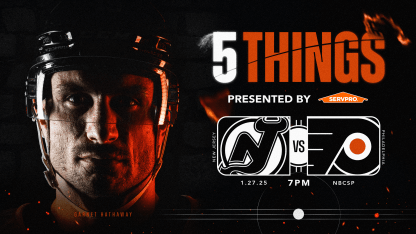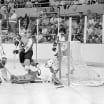John Tortorella's Philadelphia Flyers (22-22-6) will open a home-and-home set on Monday evening against Sheldon Keefe's New Jersey Devils (28-18-6). Game time at Wells Fargo Center is 7:00 p.m. EST. On Wednesday, the venue will shift to Prudential Center in Newark.
The game will be televised on NBCSP. The radio broadcast is on 97.5 The Fanatic with an online simulcast on Flyers Radio 24/7.
Monday's game will mark the second of three meetings in January between the Flyers and Devils. On January 18 in Newark, the Flyers skated to a 2-1 victory. Matvei Michkov scored a breakaway goal while Bobby Brink tallied a third period power play goal. The season series will conclude on March 9 at Wells Fargo Center.
The Flyers saw a 5-0-1 stretch come to an end with back-to-back road losses on Thursday to the New York Rangers (6-1) and Friday to the New York Islanders (3-1). Since the Devils last played the Flyers, New Jersey has gone 2-1-0. This past Wednesday, New Jersey skated to a 5-1 home win over the Boston Bruins. On Saturday, the Devils earned a 4-3 overtime road win against the Montreal Canadiens.
Here are five things to watch in Monday's game. Many of the same driving factors that contributed to the Jan. 18 win in Newark also apply to the home-and-home against the Devils this week.
1. Shot suppression
In Philly's 2-1 win over the Devils on January 18, the Flyers blocked 33 New Jersey shot attempts while allowing a mere 13 shots on goal. Over the last two games, the Flyers haven't been able to come up with timely blocks -- or saves -- on several opposition goals that were redirected on deflections from the slot.
Containing New Jersey's speed in transition is an ever-present challenge to beating the Devils. But so is snuffing out shot attempts with quick sticks and, as needed, crucial shot blocking.
In the losses to the Rangers and Islanders, the Flyers respectively yielded 37 and 27 shots on net while blocking 17 against the Rangers and just 13 against the Islanders. While blocking 30-plus again versus New Jersey is a big ask, the Flyers may need to come up with something in the neighborhood of at least 22 to 25 blocks. Philadelphia leads the NHL with an average of 17.85 blocks per 60 minutes.
2. Getting out of offensive mini-slump
The Flyers got in a good offensive groove in the 26-game span between Nov. 25 and January 18. During that stretch, Philly ranked fourth in the NHL with an average 3.31 goals per game. Only Tampa Bay (3.72), Edmonton (3.63) and Pittsburgh (3.36) scored at higher clip over that seven-week span.
However, over Philly's last three games (vs. Detroit and the back-to-back defeats by the Rangers and Islanders), the Flyers have mustered only one regulation goal apiece in each of the last three games.
Joel Farabee scored (assisted by Sean Couturier and Michkov) in the second period of the eventual 2-1 overtime victory against the Red Wings. Owen Tipppett (assisted by Travis Konecny and Morgan Frost) tallied on a 3-on-1 rush in the opening 85 seconds of the Rangers game. In Elmont, Tyson Foerster (assisted by Konecny and Erik Johnson) scored on a 2-on-1 rush in the first period. Puck carrier Foerster elected to shoot and found the mark.
Even in the last game against the Devils, the Flyers mustered two goals on a meager 18 shots on net. That necessitated the aforementioned 33 blocks, 12 saves from Samuel Ersson, plus a favorable coach's challenge on an offside New Jersey entry that erased a third-period Jesper Bratt goal from the scoreboard.
Regardless of the source, the Flyers may very well need to create -- and finish -- more offense than they have in the last three games. Starting the third period of the Rangers game and then for much of the latter 30 minutes of the game against the Islanders, Tortorella put his line combinations in a blender -- for the first time in a couple of weeks - while changing up power play personnel and deployment order.
The tweaked lines didn't have much effect on either the MSG or Elmont games. Sunday's practice, for the most part, saw the team revert to the now-familiar combos of the last few weeks: Cates centering Foerster and Brink, Frost centering Tippett and Konecny, and Couturier centering Farabee and Michkov across the top nine.
However, if those combinations do not click relatively fast against the Devils -- especially if the Flyers are forced to play from behind -- it would not at all be surprising if Tortorella switches on the blender once again for his 5-on-5 lines up front.
Blueline combos from Sunday's practice had Travis Sanheim with Jamie Drysdale, Cam York with Rasmus Ristolainen and Nick Seeler with Johnson.
Egor Zamula (day-to-day with an upper-body injury) did not play on Friday or practice on Sunday.
Power play personnel in Elmont had Drydale, Cates, Konecny, Foerster and Anthony Richard on the first unit. The second unit featured Ristolainen, Frost, Tippett, Brink, and Michkov.
3. Laughton returns to the lineup
Alternate captain Scott Laughton has been unavailable to the team over the last three games. He took a short leave to deal with a personal matter. Laughton returned to the team on Sunday and practiced with the team.
At Sunday's practice, Laughton practiced at left wing on a line with center Rodrigo Abols and right winger Garnet Hathaway. Richard also mixed-and-matched into some reps on the wing.
Ryan Poehling (IR, upper body) skated on his own on Sunday, under the supervision of head trainer Tommy Alva. He is not ready to return to play yet but is making progress.
4. Between the pipes
The last time the Flyers played the Devils, Ersson opposed Jake Allen in what turned out to be a very low-event game (which can sometimes be tougher on goalies than higher volume workloads).
Ersson played better last Thursday against the Rangers than his stat line (31 saves on 36 shots) would suggest. However, with Igor Shesterkin now red-hot for New York, Ersson was unable to elevate his game that night to his "A" form.
With No. 1 Devils goal Jacob Markstrom sidelined four-to-six weeks with a knee injury sustained against Boston, Allen will take over primary starting duties for a while. He is backed up by 22-year-old Isaac Poulter, who was called up from Utica on Friday. The more experienced Nico Daws is also an option for the Devils if recalled.
5. Second period: long time change
Given the Devils' team speed and skill in transition, it is not a surprise that New Jersey is adept at counterattacking quickly when their opponents are caught up ice or attempt an ill-timed line change. This is especially true in the second period of games, when there is a longer skate to complete changes on the fly.
This is not the only reason why the Devils are a very good second period team, but it's a contributing factor. Overall, New Jersey has outscored opponents in the second period by a 62-37 margin. In first periods, New Jersey has been slightly outscored (35-37). Third periods are 57-49 in the Devils' favor.
The Flyers, by comparison have struggled in the second period, yielding 60 goals while scoring 46. In the first period, the Flyers have slightly been outscored by a 42-40 margin. Third periods have seen the Flyers score 56 goals while giving up 63.



















